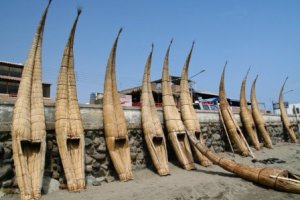
|
|
PESCANDO CON CABALLOS
CABALLITOS DE TOTORA
| .More than 1200 years ago in the coastal area of Peru the Mochica culture thrived. Some of their traditions have survived on engravings on pottery discovered from the period. One of these traditions, of using small craft or `tups` made from totora cane for fishing the bounty of the ocean, has just about survived to the current time. |  |
|
 |
In Huanchaco, a small beach 450 km north of Lima, these `caballitos de totora` can still be seen today, albeit in decreasing numbers. The name was given to the boats by the Spanish colonists, after the manner in which the fishermen launched them into the sea. The craft are three to four metres long and about one metre wide. | |
| They are constructed from the locally grown totora cane. Craftsmen weave and shape the cane into the form of a boat with a pointed bow. The fishermen launch their boats early in the morning searching for areas of plentiful fish and seafood. Their skilful sailing of the cane crafts are quite a tourist attraction nowadays. |  |
|
 |
However they still hope to bring back good catches to earn their livings from all their hard work.Their impressive crafts are stood on end on the beach to dry out, looking like soldiers guarding the coastline. However like many long-standing traditions, this form of fishing is in decline. The children of the fishermen do not want to follow in their fathers` footsteps into such a hard way of life. | |
| The bright lights of Lima appear to offer them a better future. Also the introduction of trawler ships in the area are decimating the fish stocks, leaving little for the traditional fishing techniques. Sadly it is likely that the ancient tradition of the Mochica `tups` will be but a distant memory within a few decades |
 |
|
Copyright © and TM 2007-2024 fun-learning-spanish.com |
Advertisements / Anuncios |
|
Visit / Visitar La Manga |
FLIGHTS / VUELOS HOTELS / HOTELES
|
Books on / Libros sobre La Manga |
|
|
Other things to view on our website / Otras páginas interesantes en nuestro sito |
Mojitos - Cuban cocktails / cocteles cubanos
|
Our travel guide of Spain / Nuestra guía de España
|



